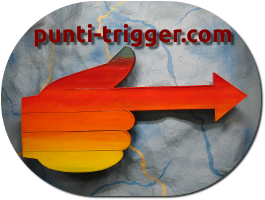Trigger Point therapy essentially requires a mechanical factor that interrupts the autogenous vicious cycle which determines the energetic crisis and which in turn is caused by the energetic crisis itself, owing to the contraction at the level of the muscle sarcomeres.
While in the medical settings needles are used to attempt perforation of TPs, to us such technique appears unjustifiably bloody and dangerous, even when operated by an expert physician. As a matter of fact, it is often necessary to probe, i.e. pierce repeatedly, the involved area, and it is easy to imagine what damages can be caused to the patient in the event the operating physician runs into a nerve, a glans or a blood vessel.
As far as we are concerned, the rational techniques are essentially two: specific deep tissue massage manual techniques, and specific stretching.
In this and in the following article, we intend to illustrate the fundamentaland essential "tools" of Trigger Point manual massage techniques, while we'll address the specific stretching concepts and techniques in future articles.
In the first place, it is necessary to adopt a methodical approach in regard to the identification and localization of the TPs. The related techniques are based on the notion that a TP is located in a taut band of muscular tissue. The first step toward the identification of the TP will then consist of the palpation of the muscle with the aim of determining the taut band, i.e. the bundle of muscle fibers that because of hypertension due to TP contraction, has taken the consistency of a tight rope.
The main taut band palpation techniques are three:
- Flat hand palpation: the fingers of the hand are moved back and forth orthogonally to the direction of the muscle fibers, pushing these against the underlying muscle, until the taut band is found.
- Pincer grip palpation: the muscle is grasped between the thumb and the other fingers and rolled between the fingers that thus take a pincer shape.
- Snapping palpation: the taut band is pressed laterally by one or more fingers, and then the pressure is suddenly released as when pluckering a guitar string. The typical reaction in this case is an involuntary contraction of the muscle fibers, which is typical of a muscle affected by TPs.
The first two techniques mentioned above are the main methods used to identify the taut bands. The flat hand method is suitable for deep muscles and those close to the bone, while the pincer method is good for muscles more superficial and elastic such as the sternocleidomastoid and the trapezius. The third method is used to confirm that you have discovered the TP bundle, as the reaction of involuntary contraction is proof of the presence of the TP itself.
Once the taut band is found, one can proceed to the localization of the TPs themselves. As a general rule, the main TPs are typically located in the central part of the muscle fibers. That said, however, one needs to make some clarifications.
First of all, the central part of the muscle fibers corresponds with the central part of the muscle only in cases of muscles whose fibers run parallel from one end of the muscle, eg the biceps. But there are many other cases of more complex muscle structure, where the fibers can have bipennate or unipennato orientation (ie are diagonal), or where the fibers are interspersed with tendon areas (eg the abdomen). In such more complex case, the main TPs appear toward the center of muscle fibers, but since now these do not run parallel along the entire length of the muscle, in practice one will need to explore all the muscle and not expect to find the main TPs in its central area.
Secondly, if it is true that the main TPs appear in the central part of the fibers, there are often other TPs as important that arise in the vicinity of the muscle-tendon and tendon'bone interfaces and that still need be treated.
As a general rule, therefore, seek first the main TPs toward the center of muscle fibers (which does not necessarily correspond with the center of muscle), but then one should also seek the tendon-muscle extremity and tendon-bone insertion TPs.
To complete the identification phase, it will be necessary to identify the actual TP, which will have the consistency of a small nodule, ranging in size from that of a nut to that of a pinhead.
But do not be fooled by small size: the TP cause pain and motor and autonomic dysfunction that are much more imposing than the small stature of these little devils of our muscles!
In summary, we have presented in this article the methodical approach for the detection and accurate localization of the PT. In the next article we will review the "tools" of our art.
